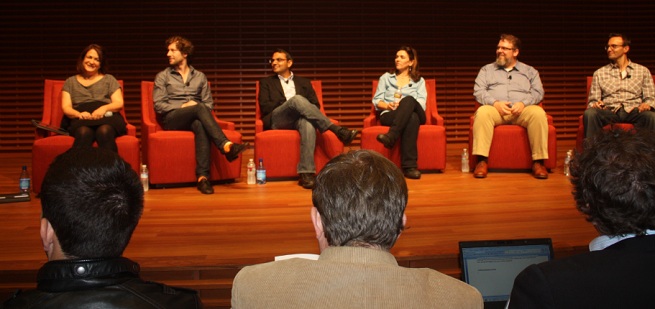Gamification, or the use of gameplay mechanics to make nongame activities more fun and engaging, has taken off in a big way. Multiple gamification companies made appearances at Salesforce.com’s DreamForce 2012 conference this week with apps that gamify sales via leaderboards and rewards. Gamification resembles the old airline loyalty programs, but now companies can access much more data and feedback from users that can make gamification more scientific and effective.
At the MIT/Stanford Venture Lab, Margaret Wallace (far left), the chief executive of Playmatics, led a discussion about gamification at the Stanford Business School in Palo Alto, Calif. From left to right, the speakers included Courtney Guertin, the chief technology officer of Kiip; Rajat Paharia, the founder and chief product officer of gamification firm Bunchball; Amy Jo Kim, the game designer and CEO of ShuffleBrain; Joshua Williams, the senior software design engineer at Microsoft; and Andrew Trader, a venture partner at Maveron. They talked about everything from using gamification to squashing bugs to the question, is gamification overhyped? The experts weigh in on that, too. Here’s some of the choice quotes from the first part of the panel.
Margaret Wallace: Everybody, please quickly introduce yourselves and tell us: Why or why not gamification? Is it compelling? Why is it compelling to you?
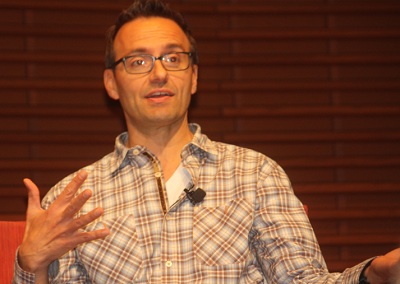 Andrew Trader: I think that’s a great question. I’m Andrew Trader — you can call me A.T. I have been really fortunate to be on both sides of the table in the world of gamification. I’ve been on the company side, I was part of the founding team at Zynga, and I’ve also been on the venture side. For the last few years, I’ve been at a consumer-focused venture firm called Maveron. I’ve seen a lot of companies that have been approaching gamification for different industries in different ways, but almost exclusively in the consumer context, so I’m going to be one of the people talking about things mostly through a consumer lens. Gamification … hell yeah. The value prop, in my mind, starts with the idea of relationship capital.
Andrew Trader: I think that’s a great question. I’m Andrew Trader — you can call me A.T. I have been really fortunate to be on both sides of the table in the world of gamification. I’ve been on the company side, I was part of the founding team at Zynga, and I’ve also been on the venture side. For the last few years, I’ve been at a consumer-focused venture firm called Maveron. I’ve seen a lot of companies that have been approaching gamification for different industries in different ways, but almost exclusively in the consumer context, so I’m going to be one of the people talking about things mostly through a consumer lens. Gamification … hell yeah. The value prop, in my mind, starts with the idea of relationship capital.
This is one of the really important concepts around what makes social games, like at Zynga … what makes Farmville so compelling? When we were starting Zynga, we had these three priorities: They were reach, retention, and revenue. There’s a lot of applicable things about gamification that you find not only in social gaming, but also in all these other applications, whether they’re consumer applications or enterprise applications. What you’re trying to do is incentivize the right behavior. It might be competitive or collaborative, but you’re trying to incentivize the user to engage more deeply or spend more money. The elements that drive gamification in social games are also the things that drive gamification in other consumer applications.
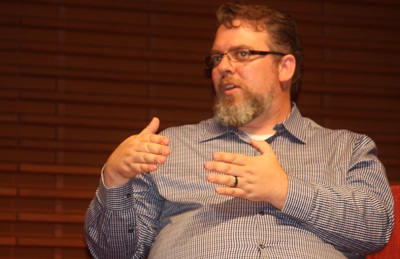 Joshua Williams: My name’s Joshua Williams. I work at Microsoft. Specifically, I work in the Lync group. Games really weren’t our business. What we were trying to do is find a way of making our own jobs more interesting.
Joshua Williams: My name’s Joshua Williams. I work at Microsoft. Specifically, I work in the Lync group. Games really weren’t our business. What we were trying to do is find a way of making our own jobs more interesting.
Those of you in software development are probably familiar with a classic game, the Bug Bash. Everyone beats on a feature for a day or two, and the person who finds the most bugs gets a prize. That type of game has been around forever in software development for a long time. But we thought, what if we could add more elements to it? What if we could add a different reward structure, so it wasn’t always just for the top one? What if we did drawings? What if we gave away prizes? How can we test in a more engaging and fun way? There are parts of work that are, well, work. Why not find a way to make them more fun and engaging? A lot of what was done was experimental. We tried some things that worked and some that failed miserably. Hopefully, we learned from those, though. I think we’ve had some good success. We came up with the name “productivity games.” We wanted to make a game where we increase the productivity of a group of people because it makes work less painful and more engaging. That’s where the concept of gamification, in a larger sense, has a lot of challenges. It can create more problems than it helps with, and it can also solve huge problems that can’t be solved in any other way. So I’d say it’s a double-edged sword.
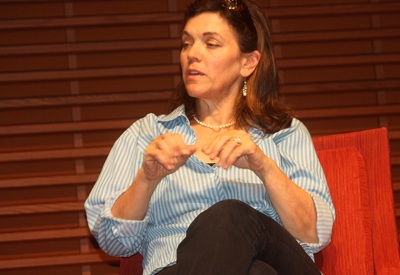 Amy Jo Kim: I’m Amy Jo Kim, the cofounder of ShuffleBrain. We are a design company. I have been doing both game design and web and social media design for a long time, before gamification was around. I’ve long been interested in sharing my ideas about how to take much of what makes games fulfilling and translate that into a broader range of products and services. I worked very early with eBay, translating their systems into something that was more compelling — working their featured sellers program into a notification system, that kind of thing.
Amy Jo Kim: I’m Amy Jo Kim, the cofounder of ShuffleBrain. We are a design company. I have been doing both game design and web and social media design for a long time, before gamification was around. I’ve long been interested in sharing my ideas about how to take much of what makes games fulfilling and translate that into a broader range of products and services. I worked very early with eBay, translating their systems into something that was more compelling — working their featured sellers program into a notification system, that kind of thing.
A lot of my practice basics in the last few years have been in implementing and tuning the social systems that underlie many different kinds of websites and mobile products — reputation systems, those sorts of things. You could certainly call it gamification. That word has rubbed me the wrong way, and I think many people in the games industry or who come out of gaming have that experience.
What very early forms of gamification did is take [what] are actually not the key things that make games compelling — the external progress markers. They put those in place without a thought to experience strategy, or thinking about what experience you need to be delivering over time. My perspective is that’s what makes games compelling — much more so than those progress markers. … There’s nothing wrong with a progress bar. I love a good progress bar. But a lot of what makes games actually compelling over time is when they unfold new experiences and when they’re giving me new things to learn and master. You want to have just the right amount of challenge to keep people engaged.
A lot of my personal work is in designing systems to be more like that even if they don’t look like games. What’s exciting to me is seeing how quickly people are getting more sophisticated. Now, when people say, “Oh, gamification. All those points and badges,” that was last year. I think people are getting smarter andfaster. They’re recognizing the limits. They’re strengthening motivators and intrinsic rewards. They’re designing systems that have the dynamics of games and the feel of games. That’s what’s really exciting to me. The other piece that is a big promotional opportunity — and I would encourage you guys to explore it — is to look at the big world of non-zero-sum gaming. Zero-sum gaming is games where we’re opponents, and you’re dividing up a pie into pieces for people to take when they win or lose.
That’s great. Most of computer gaming has been zero-sum gaming. Today’s audience has dramatically changed in the last few years. It’s going mobile. It’s going toward both genders and all ages. If you look at the trends, what you see is that a lot of the growth is in mobile and social: games where both genders are playing in equal numbers. What that means is there’s a huge opportunity for non-zero-sum gaming, games where we’re partners instead of opponents. In the next three to five years, we’re going to see some tremendous innovation there, both in the consumer world and also in collaborative systems inside of companies. I think that’s a very exciting new frontier.
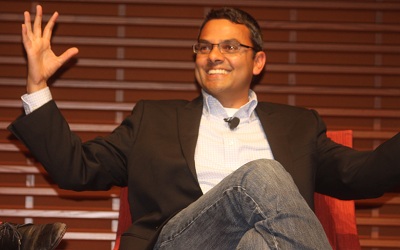 Rajat Paharia: My name’s Rajat Paharia. I’m the founder and chief product officer at Bunchball. We created the gamification industry in 2007. We actually didn’t know what to call it back then; we didn’t have a marketing team at the time. In 2009, we started using the word “gamification,” and that’s when the term kind of took off. On the one hand, I’m sorry, but on the other hand. … The industry has a term, and I’m happy that there’s a word for it.
Rajat Paharia: My name’s Rajat Paharia. I’m the founder and chief product officer at Bunchball. We created the gamification industry in 2007. We actually didn’t know what to call it back then; we didn’t have a marketing team at the time. In 2009, we started using the word “gamification,” and that’s when the term kind of took off. On the one hand, I’m sorry, but on the other hand. … The industry has a term, and I’m happy that there’s a word for it.
But if you’re allergic to the term, then there’s a bunch of other ways to look at what gamification is. There’s “measure and motivate.” There’s “reward and recognition.” “Reputation.” “Loyalty.” “Guiding and amplifying.” All those things are really what you’re doing with a gamification system. They’re just different ways of saying it. They don’t matter to the game designers.
What happened in 2007 was we realized that we were living our lives completely online: our community lives, our entertainment lives, and our work lives. Everything we’re doing is now being mediated by technology, and because of that, it’s generating data — data on our utilization. Right now, all this data is kind of floating free in the atmosphere. But smart companies can take that data, consume it, and leverage it to drive high-value activity and motivate people to do things.
People with loyalty programs and frequent-buyer programs have been doing this for years. But the only data set they have is transactional data, or what you purchase when you’re buying airline tickets or whatever. That’s the only set they have. But now, we have this wealth of data about user activity flying out there all the time. We want to capture, leverage, and start utilizing it because it’s telling us what your users are doing. They’re holding up their hands all the time and telling you about everything. They’re telling you what they’re good at, what they’re bad at, what they hate doing, and what they like doing. All that information is there. That’s what gamification does.
In 2007, we said, “Let’s bring a platform that’s made to consume this big data stream and then use these techniques that game designers have used for years to motivate people.” Things like goal-setting, real-time feedback, competition, transparency, teams, leveling up, badges — all those things. Let’s take those and use them to drive the high-value activity and loyalty. We’ve been doing that since 2007. We started in the consumer space with brands like CBS and NBC … media companies with community sites that wanted to engage their audience members and their fans and try to drive high-value behavior there. Since then, we’ve gained more partners and more employees. The stuff has migrated from the consumer space into the enterprise space. We’re working out how to motivate employees to sell more, be more social, recruit their friends, help desk activities, work with training, and collaborate more internally. That’s actually the fastest-growing part of our business right now.
Wallace: So, Courtney, I’m going to start off with a question for you. I know that you mentioned that Kiip really isn’t and hasn’t set out to be a gamification platform. You’re really focused on the moment of achievement and rewards. Do you want to speak to how you do gamification in terms of what you’re doing? And maybe as a second part to the question, how are you seeing brands react to or adapt to not only rewards, but also gamification using your platform?
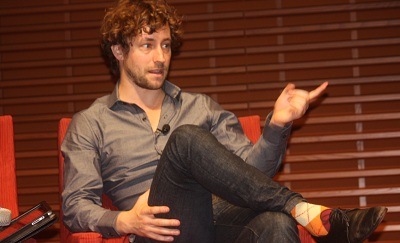 Courtney Guertin: When we first started out, there was a tremendous amount of education. Where we get our rewards from is the brands, and they still didn’t realize that, honestly, every single person in the demographic sphere is using and playing games. It is middle-aged mothers, young children, and people over 50. There was a lot of education there. And actually, after you overcome that and show them the data. …
Courtney Guertin: When we first started out, there was a tremendous amount of education. Where we get our rewards from is the brands, and they still didn’t realize that, honestly, every single person in the demographic sphere is using and playing games. It is middle-aged mothers, young children, and people over 50. There was a lot of education there. And actually, after you overcome that and show them the data. …
What we set out to do is let the game developers we partnered with design their own game. They know where they want to bring the users. We’re not there to go to them and say, “Hey, this is a better game mechanic versus that one.” What we wanted to do is. … They have specific and set goals they want users to accomplish. When they’re doing that, and they try really hard to do that, we serendipitously give them a reward. It’s more of a surprise and delight. There’s not a very direct path to any of the tailored rewards we might give them. People are using this app the way the game developer has designed it to be used. We’re there just as an added thank-you.
We do it in a way where it doesn’t take you out of the application. What we’ve seen is that over the last couple of years, brands are now really, really knowledgeable about how engaged people are in games. It’s been sprinkled in even in the work environment.
That’s where gamification kind of gets a bad name. It’s because people weren’t thinking about it as a real thing. They just say, “Oh, the Silicon Valley gamification dust. I’ll sprinkle that on my app, and now I’ve gamified it. I’ll make 800 grand.” That’s crap.
What you really need to do is just figure out … what, uniquely, is the great experience for me? How can I get more out of it? Has everyone heard of the Fun Theory? Go to funtheory.org. You’ll be blown away by what they’ve been able to do — simple things like throwing away trash in a trash can. You throw it away, it makes a sound, and it has this little alarm that goes, “Dooo!” You play that for people throwing trash in it, and then they’ll wander around trying to find other trash to throw away. Or wanting to go upstairs. They wanted to get people to stop taking elevators. They filmed it for maybe a week prior. There was a big thing of stairs here, and nobody’s taking it. Then they put a piano step over here on the stairs. Everyone is suddenly dancing up the stairs. It makes everyone happy. Now you’re dancing on your way to work. That’s the gamification that I like, and that’s what I’m inspired by.
In what we’re trying to do here, at least in the world that I’m in … we’re not trying to do the gamification layer. We really are the rewards layer. We just enhance that experience a little bit. We take brands and give them a way to say, “Hey, when you’re happy, we want to be there with you, too. We know that you’re playing in all these different areas. We just want to give you something.”
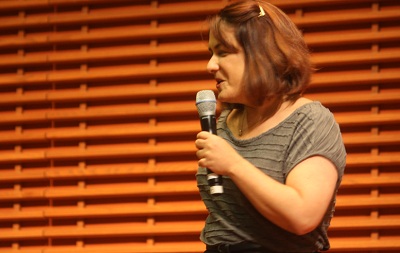 Wallace: Rajat, what do you say to entrepreneurs who come to you who don’t have a product on the market, and they’re trying to evaluate whether gamifying elements or adding some kind of qualities of gamification to their product makes sense or not? And as a second part, what’s the worst thing you’ve seen in terms of implementation that everyone in the audience should steer clear of?
Wallace: Rajat, what do you say to entrepreneurs who come to you who don’t have a product on the market, and they’re trying to evaluate whether gamifying elements or adding some kind of qualities of gamification to their product makes sense or not? And as a second part, what’s the worst thing you’ve seen in terms of implementation that everyone in the audience should steer clear of?
Paharia: If you have a news site, but you don’t have fresh news every day, no amount of gamification is going to help you. Your product has to have some intrinsic value — some reason to exist — that your users want. So that’s number one. You don’t have a product there, and that’s a different problem. You need to figure that out.
Number two, you need to figure out what is the meaningful value for your end user to participate in your gamification program. This gets into the whole thing of rewards. The easiest thing to do is throw money at people — dollars, swag, or stuff like that. But often the things that motivate people aren’t related to that. They can be early access to content. The Deal Freak was one of these daily deal sites in New York. Every day, there’s a new deal at noon, and there’s a limited number of them. So you get there in a scrum with everybody else. Maybe you get it, and maybe you don’t. If you spend $25,000 dollars with the Deal Freak, you level up and get in at 11:45. It costs them nothing to fulfill, but it means everything to these people because they’re guaranteed to get the deal that they want.
If you’re part of the Lady Gaga fan club — and I know that all of you are — and you’re one of her top 100 fans, she gives you a choice: $100 dollars or insider access to the tour diary that nobody else has. I can guarantee you that everyone in that top 100 will take the insider access. That content, if you’re a passionate fan of Lady Gaga, matters more — having this insider knowledge and being the one who can share it with the world and be the hero. That’s power. All these kinds of things mean more to people than actual dollar-value rewards.
That’s the second thing to think about. In your context, what is the meaningful value you can provide? As an example of that kind of gamification, I’m going to give you one that I think is a double-edged sword. It’s a good one for entrepreneurs to look at. This is Foursquare. Foursquare, for a while, was the poster child for gamification: really good for onboarding, really bad for retention. It’s an amazing use of gamification for onboarding. On day one, you got Foursquare. It just launched, and they need you to press a button to check in because they need that check-in data so they can derive some value from the service. Then they can go to local merchants, make deals, and start recommending things. But they have no data. So they need you to press the button. What do they do? They use gamification. They’ve got points, and you earn badges — all that stuff — and that gets me to press the button. I’m pressing the button for a week, two weeks, three weeks, or a month. For some period of time, I’m engaged.
And then, almost inevitably, somebody wakes up and says, “Why am I pressing this button? I need to get some value out of this.” That’s when Foursquare has to deliver some value. They have to deliver hot singles nearby or discounts off of local merchants. You can see that they’re trying all of those. Gamification there is not a retention tool. They’re not using it for sustained engagements. They’re only using it for onboarding, and because of that, it’s great for stacking people up to a point. But after that, they have to actually deliver value. To get that data, they have to make that data valuable to people.
Part two of the panel will appear tomorrow.
VentureBeat's mission is to be a digital town square for technical decision-makers to gain knowledge about transformative enterprise technology and transact. Learn More
